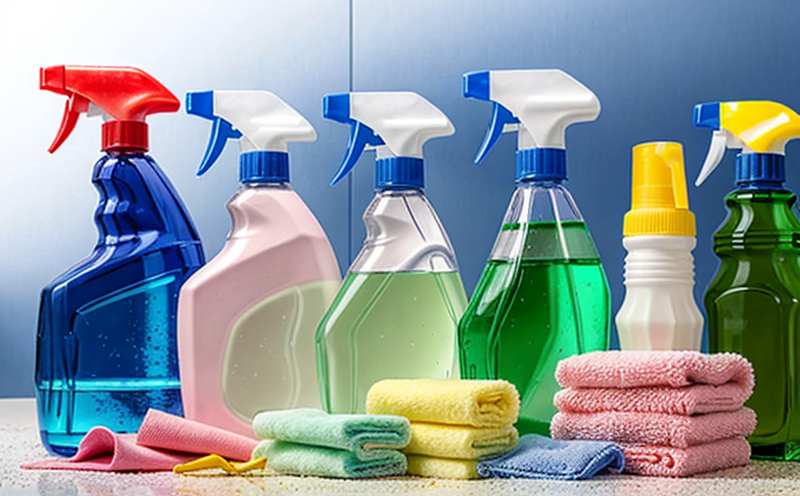Stability Testing of Cleaning Products
The stability testing of cleaning products is a critical process in ensuring that products meet regulatory standards and perform consistently throughout their shelf life. This service focuses on evaluating the chemical, physical, and biological stability of cleaning agents over time under various environmental conditions.
Stability testing is particularly important for consumer products due to the diverse range of environmental factors they may encounter from manufacturing to end use. The process involves exposing samples to different storage conditions such as temperature, humidity, light exposure, and even packaging integrity tests to simulate real-world scenarios. This ensures that cleaning products remain effective and safe for consumers.
The testing begins with careful selection of the sample batch, which should be representative of the production run. Once selected, samples are subjected to controlled environmental conditions designed to accelerate degradation processes while maintaining a realistic simulation of storage and use environments. The results provide insights into potential shelf life limitations and necessary adjustments for product formulation or packaging.
The testing process is governed by international standards such as ISO 12945-3:2017, which provides guidelines for the preservation of cleaning products during storage. Compliance with these standards ensures that tests are conducted in a manner that is both consistent and relevant to real-world conditions. This approach helps manufacturers ensure that their products will perform reliably when used by consumers.
Environmental factors play a significant role in the degradation of cleaning products. For instance, high humidity can promote microbial growth, while extreme temperatures can alter chemical compositions. Stability testing helps identify these vulnerabilities early on, allowing for corrective measures to be implemented before product launch. This proactive approach not only enhances quality but also supports regulatory compliance.
Moreover, stability testing aids in optimizing the formulation of cleaning products. By understanding how different ingredients interact under various conditions, manufacturers can refine formulations to enhance performance and extend shelf life. This is especially important for eco-friendly formulations where preserving efficacy without compromising sustainability goals is a key challenge.
- Temperature Variations: Testing at extreme temperatures helps determine the limits of product stability in both hot and cold climates.
- Humidity Levels: High humidity testing identifies potential issues with microbial growth or chemical breakdowns due to moisture absorption.
- Light Exposure: Ultraviolet light exposure tests assess the impact of sunlight on product integrity, ensuring that products retain their effectiveness over time.
Why It Matters
The stability testing of cleaning products is crucial for several reasons. Firstly, it ensures product safety and efficacy throughout the shelf life, which is essential for consumer protection. Secondly, it helps manufacturers maintain consistent quality across different production batches and geographical locations. This reliability is vital in building and maintaining brand reputation.
From a regulatory perspective, compliance with international standards like ISO 12945-3:2017 is necessary to meet legal requirements and avoid potential recalls or product withdrawals. Non-compliance can lead to significant financial losses and damage to the company's public image.
In addition, stability testing plays a crucial role in sustainable manufacturing practices by identifying opportunities for reducing waste and improving resource efficiency. By understanding how products degrade under different conditions, manufacturers can design more durable packaging solutions or reformulate products to be less sensitive to environmental factors.
The service also supports the development of new product formulations that meet emerging market demands while ensuring they are safe and effective. This aligns with broader trends towards green chemistry and sustainable production processes.
Applied Standards
The stability testing of cleaning products adheres to a range of international standards designed to ensure the reliability and consistency of test results. These include:
- ISO 12945-3:2017 – Preservation of Cleaning Products During Storage: This standard provides detailed guidelines on how to conduct stability tests for cleaning products, focusing on the preservation aspects during storage.
- ASTM D6882 - Standard Specification for Biodegradable Plastics and Articles: Although not directly related to stability testing, ASTM D6882 specifies criteria for biodegradability, which is often a key factor in determining the environmental impact of cleaning products.
- EN 13927 – Sustainable Product Declaration (SPD): This standard helps manufacturers provide transparent information about the environmental impacts of their products throughout their lifecycle, including stability testing results.
The use of these standards ensures that the testing process is rigorous and comparable across different laboratories, providing a robust foundation for decision-making in product development and quality assurance.
Environmental and Sustainability Contributions
Stability testing contributes significantly to environmental sustainability by helping manufacturers design more durable products that require less frequent replacement. This reduces waste generation and extends the lifecycle of packaging materials, which is particularly beneficial for single-use items like cleaning cloths or disposable scrubbers.
By identifying factors that contribute to product degradation, stability testing can also guide the development of more sustainable formulations. For instance, using biodegradable ingredients not only reduces environmental impact but also ensures that products decompose safely at end-of-life without contributing to pollution.
The testing process itself is conducted in a way that minimizes resource consumption and waste generation. This includes optimizing test conditions to minimize energy use and reducing the amount of material used for sample preparation. By adhering to these practices, laboratories contribute positively to environmental sustainability while providing valuable insights into product performance.





